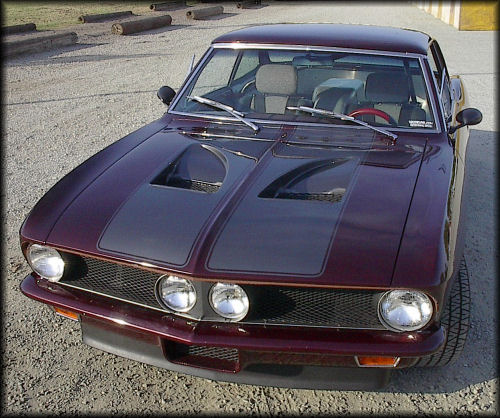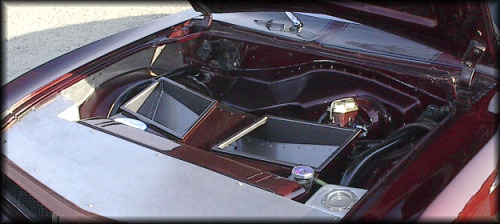

![]()
A stroked 383 cubic-inch Corv-8 Monza Roadster
|
Archibald Evans grew up with Corvairs. Before his second birthday he rode in a 1960 Corvair sedan owned by his father, Archibald, Sr. The senior Evans was intimately familiar with Corvairs, and not just because he owned one. His investment in the car was much greater than the sticker price. As one of the General Motors engineers assigned to the Corvair project during the mid-to-late-'50s, he invested his career efforts in the development of Chevrolet's rear-engine compact as it was prepared for introduction to the public in the fall of 1959. During his tenure at GM's Chevrolet Division in Detroit, Evans car-pooled to work with a fellow Chevrolet engineer, Ed Glowaki, who at the time was promoting the Corvette racing program within Chevrolet. Stories of traveling perpendicular to the boulevard on the way to and from work with Ed at the wheel of his street driven race Corvette became Evans family folklore. So, we're talking about a father-and-son thing here. Evolution...starting with the excitement and romance of an epic era at Chevrolet being passed down a generation to someone who would carry the torch into the 21st century. The Evans' family Corvair story didn't end in Detroit. Their first Corvair took them to Denver after Evans accepted a job with Martin Marietta to work on the Mercury and Gemini aerospace programs. Later, Evans' work took him to California, and the little sedan was pressed into service carrying the family over the Rockies to a new home in Los Angeles. It was 1965 and time for a new car, and a 1965 Monza was chosen, Sierra Tan in color, equipped with a 140 hp engine, 4-speed stick and factory air-conditioning. The added excitement of the late model Corvair fueled a love affair that eventually included several more Corvairs including the top-of-the-line Corsa. By the time the younger Evans was in junior high school, he wanted to build a really souped-up Corvair. At 18 and against the advice of mid-engine Corvair guru Ted Trevor, he stuffed an Ed Pink big block Chevy engine into the back seat of a late model Corvair sport coupe. Ted Trevor, as mentioned in the Corv-8 section of this site, was the owner of Crown Manufacturing Co., Inc., of Newport Beach, California. In the late '60s, Crown brought a conversion kit to market making it relatively easy to shoehorn a Chevy V-8 into the back seat area of the late model Corvair, adapted to the stock transaxle. Crown experimented with both the small-block (327 and 350 cubic-inch) and big-block (396, 402, 427, 454 cu. in.) and determined the big-block variant was a parts breaker. The torque of the big engine was too much for the 'vair transaxle. Archibald reconfirmed Crown's findings, breaking his share of transaxle components before eventually moving on to a conversion based on a stroked small-block. Let's have a look. |
|
It's a roadster. Don't let the top fool you. It's removable, thanks to some extensive reworking. More on that later. The customized Monza is both bold and subtle, like its racing stripes. The reengineered nose incorporates round 7" sealed beam units in place of the stock arrangement of quad 5 ¾-inch headlights. Adding to the lumen count is a pair of high speed driving lights mounted front and center and hinting that this roadster is purpose-built. An air dam limits airflow under the car and helps direct cooling air into custom grillwork seemingly inspired by the '67 Camaro (which in turn, you can argue, grew out of the Corvair). |
 |
|
Air ingested through the nose is quickly put to work through a lightweight, large capacity radiator before being exhausted through NACA (National Advisory Committee for Aeronautics) ducts in the deck lid. According to Archibald, much thought went into the placement of these ducts. He explains that high and low pressure areas exist around any car as it motors down the highway. The exact location of the transition from high to low pressure varies depending on the shape of the automobile. The transitional area over the hood of a late model Corvair begins along the front axle line. The shape of the ducts is essentially triangular, deeper at the front and center, and more shallow toward the rear. This directs the warmed air from the radiator to the sides of the vehicle instead of allowing it to tumble over the windshield into the passenger compartment. At speed, the warmed air can be found at arms length along the side of the car. Further isolation of the driver and passenger from heated air leaving the radiator cavity is accomplished by the removal of the stock fresh air intakes at the base of the windshield. |
|
Dual ram-air boxes are mounted where the radiator bulkhead and fenders meet. Induction air is directed through now enclosed stock voids over the inner fenders and though holes cut into the vent plenum at the base of the windshield. It then enters the car's interior under the dash, emptying into the center console, which doubles as a plenum to the carburetor. Brilliant! |
 |
|
Good air management is critical to any mid-engine V-8 Corvair build. Cut corners and your grief will be endless. Get it right and you'll be rewarded with trouble free operation in demanding situations like backed-up freeway traffic on blistering hot days. This Corv-8 takes it all in stride with two 10-inch Spal fans pulling air through a GM 4-core motor home radiator, two more evacuating air from the engine compartment, and another fan cooling the engine's oil supply—five fans in total—all thermostatically controlled. |
Click the road sign for more.
Select from the navigation bar!